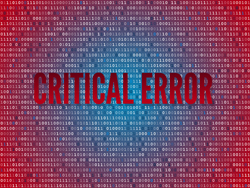To err is human and this may happen with medical transcription just as with any other task. However, it is not pardonable, especially when the errors are critical. As accurate medical transcription has a lot to do with patient health and safety, errors such as this can have serious consequences. So the professionals handling medical transcription have to be very cautious as anything below an accuracy level of 99% is questionable.
Some of the most common transcription errors include the following:
 –> Exclusion of significant dictated words
–> Exclusion of significant dictated words
–> Choosing incorrect English or medical word
–> Grammatical errors
–> Incorrect usage of words (e.g. affect and effect)
–> Punctuation errors
–> Misspelled words
–> Typographical errors
–> Use of homonyms
–> Lack of consistency (e.g. using both disc and disk in a document)
However, the errors could be critical when using incorrect terminology, excluding relevant dictated information, including information that was not dictated and incorrect patient identification. Serious mistakes in patient documentation can affect patient care and incorrect transcribed reports can lead to disastrous outcomes.
Take for instance, Sycosis that means pustular folliculitis, especially of the bearded area. Psychosis means mental or behavioral disorder. When incorrectly using these similarly sounding terms, the future medical care offered for the specific patient would be affected. Another common example is using hypertension (high blood pressure) and hypotension (low blood pressure) wrongly. The wrong medication when given for these two extreme medical conditions can seriously affect the patient.
In one of the recent real life accidents due to negligence in transcription, the cause was the insertion of an additional numeral in the transcribed report. In the original dictation, the patient’s medication dosage was mentioned ‘8’ and it was wrongly transcribed ’80’ in the document. This led to the patient receiving a dosage ten times more than what her body could withstand.
Even though nobody can assure cent percent accuracy in the medical transcription, such serious errors can be avoided with the support of reliable medical transcription services. Well-versed, trained and experienced medical transcription professionals would deliver precisely transcribed reports. There would be multiple levels of quality assurance by transcriptionists, quality analysts and editors which would in turn ensure an accuracy level of 99%.
With the introduction of electronic medical records and technology such as voice recognition, a reliable medical transcription company has a changed though more significant role to play. Medical transcriptionists now have to don the robe of medical language specialists, editing the output produced by voice recognition software and providing error-free transcripts.


